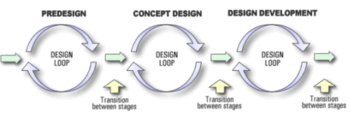Integrated Design Process (IDP)
Contents |
Abstract
The Integrated Design Process (IDP) is a high performance, holistic, method that mostly appear in conjunction with a construction project. It commonly refers to a process where the design of the construction is done in close collaboration, and with consideration for, the other disciplines. It is a process where the different design teams/disciplines (for example: Architect, Structural engineers, Building Services engineers, etc.) work closely to make sure the all of the aspects of the design is adapted to make the design as good as possible. For this reason, the term “Whole building” is often seen in the context of IDP. All of the subjects focus on making the construction with each other and the user in mind.[1][2]
Compared to the traditional design process, where one team wins the offer and then outsource the other technical tasks to different teams after a design is made, the teams interact on the same authority level. They discuss issues and opportunities to best meet the client’s requirements. The goal is to be more efficient and ensure that the quality is not jeopardized in one or more decisions, and that the different designs is integrated for its overall purpose.[3]
IDP done successfully identifies slippage and problems before the production phase and saves the project cost, enhances quality, optimizes operations in production and after and facilitates for development of sustainability in contraction.

Theory/Background
The Integrated Design Process could be seen as an offspring or underlying category of the Integrated Process or Integrated Management. It is based on the same theory to enhance the collaboration and coordination of a program or project. In a program/project management view “Integration requires making choices as to where to concentrate resources and effort, anticipating issues and dealing with them before they become critical, and coordination work for the overall success (…)”.(2) To fulfil these actions, the stakeholders must have clear requirements and the project/program team must have a common goal, not individual targets. The success of the project must be priority in every decision, this means that trade-offs and sacrifices must be made for the projects best. Every discipline must concede to work for the project’s success, not the glory of the discipline. This will give the needed basis to complete an integrated design process.
Method
A project is divided in several phases depending of what kind of project it is, but an overview of that is the four phases of the generic life cycle structure: Initiation, Planning, Execution and Closure of the project. The Integrated Design Process is mainly part of the Planning phase. Underneath that we have the Early Design Phase and the Design Phase. Here the different disciplines have to work together with close communication and collaboration to meet the stakeholder’s requirement in the best possible, and sustainable, way. [5]
When the early design phase is started, the different disciplines meet to plan how to meet the requirement within the contractual boundaries. They have to agree on the priorities in order to find the best solutions for each other, the client and the operators of the product. Creating a synergy of specialist can open for new unconventional possibilities that better solves the objectives. After the baseline is determined, the Design Phase can start. One of the most important aspects of the IDP is to have frequent contact with the disciplines to discuss decisions and adaptable solutions. This can include daily/weekly meetings, a common work platform, dedicated project offices, or LEAN-based platforms.
IDP as a PM tool
Appliance
Benefits
Example
- ↑ [1] Public Service and Procurement Canada (2018). Integrated Design Process.
- ↑ [2] Project Management Institute, (2008).The Standard for Management - Second Edition. Publisher: Project Management Institute. Page 71
- ↑ [3] Moe, Kiel, (2008). Integrated Design in Contemporary Architecture. Publisher: Princeton Architectural Press.
- ↑ IEA SHC, Task 23, http://task23.iea-shc.org/integrated-design-process, accessed: 08.02.18
- ↑ [4] Project Management Institute, (2008). A Guide to the Project Management Body of Knowledge (PMBOK® Guide), Fifth Edition. Publisher: Project Management Institute. Chapter 2.4.1.